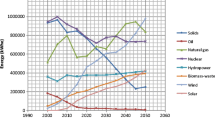Abstract
Goal and Scope
This study estimates the life cycle inventory (LCI) of the electricity system in the United States, including the 10 NERC (North American Electric Reliability Council) regions, Alaska, Hawaii, off-grid non-utility plants and the US average figures. The greenhouse gas emissions associated with the United States electricity system are also estimated.
Methods
The fuel mix of the electricity system based on year 2000 data is used. The environmental burdens associated with raw material extraction, petroleum oil production and transportation for petroleum oil and natural gas to power plants are adopted from the DEAMTM LCA database. Coal transportation from a mining site to a power plant is specified with the data from the Energy Information Administration (EIA), which includes the mode of transportation as well as the distance traveled. The gate-to-gate environmental burdens associated with generating electricity from a fossil-fired power plant are obtained from the DEAMTM LCA database and the eGRID model developed by the United States Environmental Protection Agency. For nuclear power plants and hydroelectric power plants, the data from the DEAMTM LCA database are used.
Results and Discussion
Selected environmental profiles of the US electricity system are presented in the paper version, while the on-line version presents the whole LCI data. The overall US electricity system in the year 2000 released about 2,654 Tg CO2 eq. of greenhouse gas emissions based on 100-year global warming potentials with 193 g CO2 eq. MJe–1 as an weighted average emission rate per one MJ electricity generated. Most greenhouse gases are released during combusting fossil fuels, accounting for 78–95% of the total. The greenhouse gas emissions released from coal-fired power plants account for 81% of the total greenhouse gas emissions associated with electricity generation, and natural gas-fired power plants contribute about 16% of the total. The most significant regions for the total greenhouse gas emissions are the SERC (Southeastern Electric Reliability Council) and ECAR (East Central Area Reliability Coordination Agreement) regions, which account for 22% and 21% of the total, respectively. A sensitivity analysis on the generation and consumption based calculations indicates that the environmental profiles of electricity based on consumption are more uncertain than those based on generation unless exchange data from the same year are available because the exchange rates (region to region import and export of electricity) vary significantly from year to year.
Conclusions and Outlook
Those who are interested in the LCI data of the US electricity system can refer to the on-line version. When the inventory data presented in the on-line version are used in a life cycle assessment study, the distribution and transmission losses should be taken into account, which is about 9.5% of the net generation [1]. The comprehensive technical information presented in this study can be used in estimating the environmental burdens when new information on the regional fuel mix or the upstream processes is available. The exchange rates presented in this study also offer useful information in consequential LCI studies.
Similar content being viewed by others
Author information
Authors and Affiliations
Corresponding authors
Rights and permissions
About this article
Cite this article
Kim, S., Dale, B. Life Cycle Inventory Information of the United States Electricity System (11/17 pp). Int J Life Cycle Assessment 10, 294–304 (2005). https://doi.org/10.1065/lca2004.09.176
Received:
Accepted:
Published:
Issue Date:
DOI: https://doi.org/10.1065/lca2004.09.176




